|
[Front Page] [Features] [Departments] [Society Home] [Subscribe]

Correa - Wild Fuchsia
Norm McCarthy
Correa is a relatively small genus of endemic plants of some eleven species. They are mainly prostrate to small or medium shrubs, growing to a height of plus or minus approximately 2 metres as a general guide with a similar spread. However, one species aptly known as the "Tree Correa" may achieve a height of 2 to 8 metres with a 2.5 metre spread featuring red, pink or yellow/green tubular flowers.
Correas could be dubbed the "Bread and Butter" plants of our native flora. Mostly they are easily grown in various soil types in sun or part shade. Once established, plants flower attractively for several weeks from early autumn to late spring.
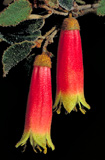 |
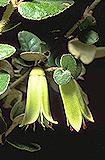 |
Correa reflexa is the most widespread and most variable member of the genus. Two forms are shown here.....Left; A typical red/yellow form from the Brisbane Ranges west of Melbourne and right, a green flowered form. The latter has a prostrate habit of growth.
Select the thumbnail image or highlighted name for a higher resolution image (27k and 32k).
|
The foliage is quite dense from the ground up and persistent at all times. Leaf shapes vary from simple, cordate, ovate or lanceolate with size variations depending upon the species. Some maybe shiny or dark mat green with the reverse or undersides pale green, white or ferruginous (rust coloured) in colour. The texture of the leaves also varies and may be smooth, scabrous or hairy. The leaves are opposite on twiggy growth and oil dots are evident on leaves which are quite aromatic when crushed.
Most plants could sprawl but judicious light pruning can retain a more compact shape if desired. However, correas readily accept hard pruning but I prefer a little and often. This promotes and stimulates new growth with a substantial increase in flowering potential. Our plants thrive in well drained red loam with an acid pH of 5.6. Good drainage is paramount and raised beds are suggested for heavy soil conditions. The application of gypsum to the soil aids texture and promotes drainage. Root rot may occur in constantly wet situations.
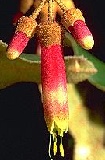 |
 |
The bell flowers of Correa lawrenciana (left) are not as spectacular as other species but that doesn't stop the birds!. On the other hand, Correa pulchella (right) is one of the most spectacular.
Select the thumbnail image or highlighted name for a higher resolution image (24k and 33k).
|
Flowers present conspicuously as four petals usually fused into a pendulous bell. Eventually this floral appendage can split at its extremity and reflex adding to its beauty. Six to eight stamens can extend a little beyond the calyx tube with pollen-presenters most evident.
This genus of plants has many colours and form variations due to natural hybridization as well as a number of contrived hybrids. The result is an infinite combination of colours and shapes. I am informed of a South Australian garden containing more than 80 plants and probably contains numerous definitive and unique crosses.
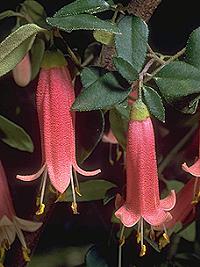 |
|
One of the most popular cultivars - Correa 'Dusky Bells'
|
|
This woody genus of variable plants occurs in all eastern states while South Australia appears to head the list with 8 species.
Correas are tough. can accept cold and are generally frost tolerant. Many flower in the winter months.
Correas have few known problems in general cultivation. However, I've heard of scale infestation followed by insidious black smut which can debilitate plants if not treated. Usually white oil or Pestoil in a 1% solution is used and sprayed on to cover completely the leaves and branches of the infected plant. Three sprays at three week intervals is normally sufficient to eradicate this pest.
Generous mulching protects roots from sunburn and discourages weeds while retaining some moisture for active growth. Long term "Osmocote", seaweed solutions or "Aquasol" are aids for plant health.
| |
 |
| |
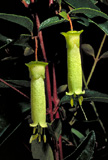 |
| |
Correa alba (top)
Correa baeuerlenii (bottom) |
I find our plants are long lived in Toowoomba with Correa baeuerlenii 25 years old and the hybrid C."Mannii" at least 10 years of age.
Of all the correas I have known and grown, 3 deserve special mention.
- Correa alba has white open attractive four petalled flowers. Unlike other species the flowers do not form a tubular configuration. It has ovate leaves and a procumbent habit.
- Correa baeuerlenii is also different and is a dense foliaged rounded shrub of lm x 2m with a sprawling habit and shiny leaves. Flowers are yellowish green tubes 2 to 3cm long. The calyx is inflated and topped with a green flattened ridge. This latter characteristic has earned it the name "Chefs Cap Correa" because of its uncanny resemblance to the article worn by a chef.
- Correa "Mannii" is an exceptional cultivar, a hybrid said to be of C.reflexa and C.pulchella. It has small dense cordate mid green leaves and lighter green reverse. New growth is often rusty in appearance on leaves and stems. The myriads of bright red pendulous bells makes this plant most desirable as a garden specimen.
Importantly, correas are wonderfully bird attractive.
From "Native Plants for New South Wales", newsletter of the New South Wales Region of the Australian Plants Society, March 2001.

[Front Page] [Features] [Departments] [Society Home] [Subscribe]
Australian Plants online - December 2001
Association of Societies for Growing Australian Plants
|